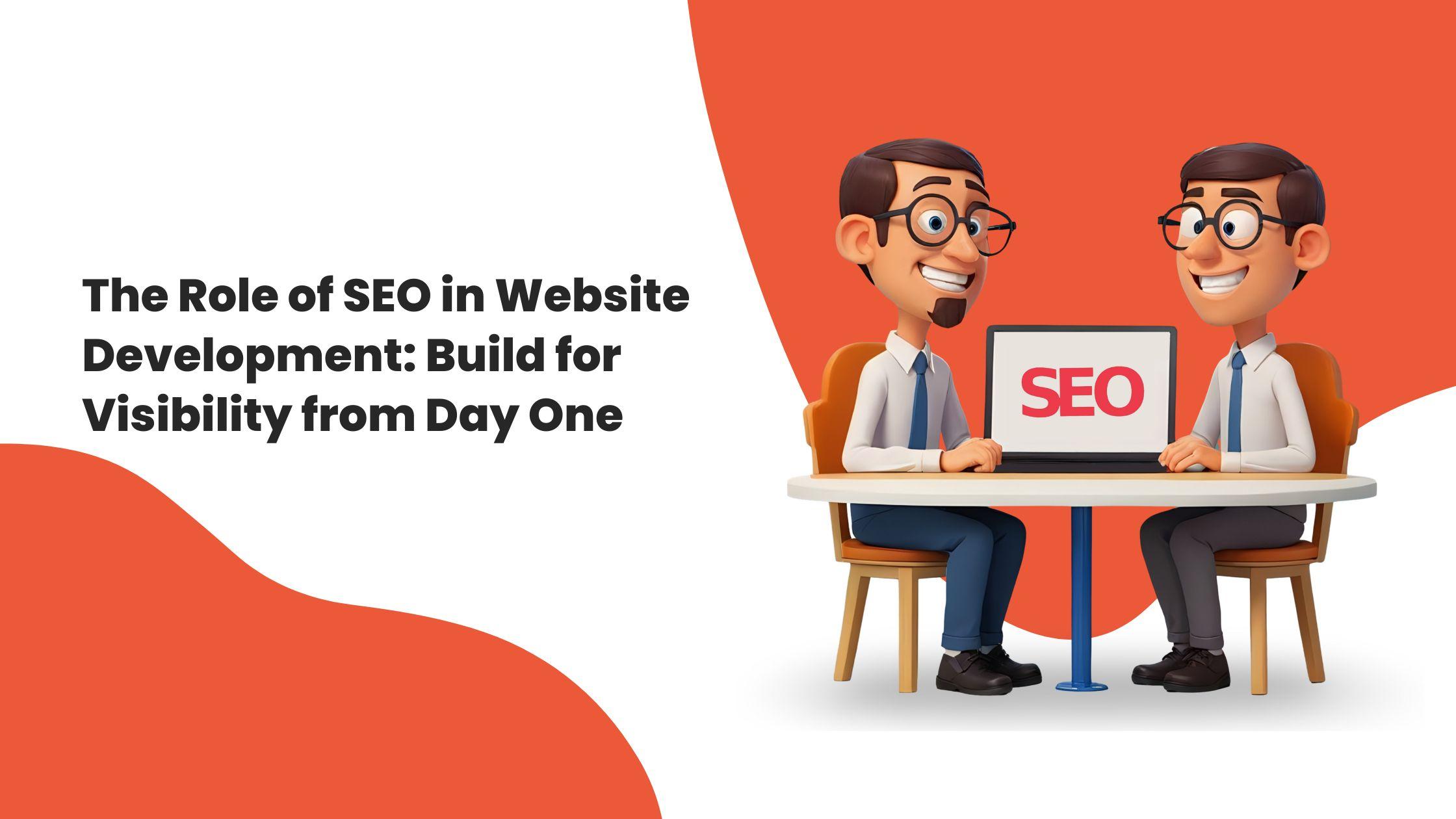
The Role of SEO in Website Development: Build for Visibility from Day One
Digital visibility requires a strategic partnership between SEO and web development since visibility has to remain a central consideration. A website that features technical excellence with user-friendly design becomes useless when search engines fail to detect or properly position it. The successful long-term development of an SEO strategy requires implementation from the initial development phases.
The core development process now needs technical SEO because search algorithms focus on websites which perform well and maintain security standards while loading quickly. Every production decision for search performance starts with clean code development and includes both mobile optimization and structure data protocols and search crawler accessibility. The content strategy and keyword mapping coupled with metadata must unite with development efforts to produce a homogenous search-friendly platform.
Businesses that embed SEO best practices from the beginning get to prevent both expensive redesigns and missed search engine ranking potential. Building with visibility in mind ensures your website becomes discoverable right from its initial launch date or existing website updates. This Article looks at how development should integrate with SEO to create better online visibility.
Why SEO Needs to Be Integrated from the Beginning

The Problem with Treating SEO as an Afterthought
Businesses traditionally performed website development alone before attempting to optimize it for search engine visibility as a separate later process. The outdated approach introduces major problems. The focus of developers on platform performance before launch typically leads them to disregard an essential SEO criterion which includes maze-friendliness, natural HTML structure and appropriate naming of web addresses. Following website launch SEO specialists need to redesign their work by starting from scratch thus resulting in process inefficiencies, payment increases, and delayed performance outcomes.
When a website starts operating it may contain duplicate content and missing alt tags as well as pages that use JavaScript which makes search engine indexing difficult. The rankings suffer from damage because of structural problems that exist in poor internal linking and non-responsive design. New Google algorithms prefer websites that demonstrate technical excellence which places sites built without SEO consideration at the beginning of a competitive ranking field. The process of retrofitting SEO fixes which includes URL restructuring and Core Web Vitals enhancement along with schema markup implementation requires extensive redevelopment work that results in website downtime together with traffic loss.
Benefits of Starting with SEO
Integrating SEO from the initial planning phase ensures a search-friendly foundation with long-term advantages:
-
Faster Indexing & Higher Visibility – A well-optimized site with a clear hierarchy, XML sitemaps, and robot.txt directives helps search engines discover and rank pages quickly.
-
Lower Costs & Fewer Post-Launch Fixes – Proactively addressing SEO prevents expensive redesigns. Using WordPress with SEO plugins as a CMS represents a smart choice since it prevents future constraints that could limit optimization efforts.
-
Stronger Technical Performance – Sites built with SEO in mind naturally align with Google’s Core Web Vitals, ensuring fast load times, mobile responsiveness, and secure connections (HTTPS).
-
Better Content & User Experience – SEO-driven development ensures proper heading structures, keyword placement, and internal linking from the start, improving both rankings and usability.
A development process integration of SEO produces faster rankings and lower maintenance expenses while providing users as well as search engines with smooth navigation. The process of achieving visibility starts with launch instead of waiting months afterward.
Core SEO Elements to Include During Website Development

1. Site Architecture and URL Structure
Well-planned site architecture ensures search engines can efficiently crawl and index your content. Key considerations include:
-
Logical Hierarchy – Organize pages in a clear, intuitive structure (e.g., Home > Services > SEO Services) to help users and search engines navigate.
-
Clean, SEO-Friendly URLs – Use descriptive, keyword-rich URLs (e.g., /seo-services/ instead of /page123?id=456). Avoid dynamic parameters when possible.
-
Internal Linking Strategy – Link related pages to distribute authority and improve crawlability.
-
XML Sitemap & robots.txt – Ensure search engines can access important pages while blocking irrelevant ones (e.g., admin sections).
A poorly structured site leads to indexing issues, duplicate content, and lost ranking potential.
2. Mobile-First & Responsive Design
Since Google uses mobile-first indexing, your site’s mobile version determines rankings. Best practices include:
-
Responsive Design – Ensure content adapts seamlessly across all devices (no separate mobile URLs).
-
Touch-Friendly Navigation – Buttons and menus should be easy to use on smartphones.
-
Avoid Blocking Resources – CSS, JavaScript, and images must be crawlable on mobile.
-
Test with Google’s Mobile-Friendly Tool – Confirm your site meets usability standards.
A slow or poorly optimized mobile experience hurts rankings and increases bounce rates.
3. Site Speed Optimization
Page speed is a ranking factor and directly impacts user experience. Optimize by:
-
Minifying Code – Remove unnecessary characters from HTML, CSS, and JavaScript.
-
Compressing Images – Use WebP format and lazy loading to reduce load times.
-
Leveraging Browser Caching – Store static resources locally to speed up repeat visits.
-
Choosing Fast Hosting – Use a reliable CDN (Content Delivery Network) and premium hosting to minimize server delays.
-
Monitoring Core Web Vitals – Aim for good scores in LCP (Loading Performance), FID (Interactivity), and CLS (Visual Stability).
Sites which take a long time to load create user dissatisfaction as users abandon these pages more quickly.
By integrating site structure, mobile optimization, and speed enhancements during development, you create a technically sound website that ranks faster, delivers a better user experience, and avoids costly post-launch fixes. Your site builds can determine the effectiveness of your SEO activities since website construction comes before keyword optimization.
Technical SEO Foundations Every Developer Must Know

1. Schema Markup Integration
Schema markup is structured data that helps search engines understand your content better, leading to enhanced rich results (like FAQs, reviews, and events) in SERPs. Key benefits include:
-
Improved Click-Through Rates (CTR) – Rich snippets make listings more attractive, increasing visibility.
-
Better Content Interpretation – Helps Google categorize and display your data accurately (e.g., product prices, ratings).
-
Support for Voice Search & AI – Structured data improves compatibility with voice assistants and AI-driven search.
Implementation Tips:
-
Use JSON-LD (Google’s preferred format) for easy integration.
-
Test markup with Google’s Rich Results Test.
-
Focus on relevant schemas (e.g., Article, LocalBusiness, and Product).
2. XML Sitemaps and Robots.txt Configuration
Proper crawlability and indexation control are critical for SEO success.
XML Sitemaps:
-
Acts as a roadmap for search engines to discover and prioritize key pages.
-
Should include only indexable pages (exclude duplicates, noindexed, or low-value URLs).
-
Submit via Google Search Console for faster indexing.
Robots.txt:
-
Directs search engine crawlers on which pages to access or block.
-
Common uses:
-
Blocking admin pages (Disallow: /wp-admin/).
-
Preventing duplicate content indexing.
-
Misconfigurations can accidentally block important pages—always test in Search Console.
3. Secure HTTPS Setup
HTTPS is now a ranking factor and a user trust signal.
Why It Matters for SEO & Users:
-
Security & Trust – Encrypts data, preventing breaches and boosting credibility.
-
Google Rankings Boost – Sites without HTTPS may be flagged as "Not Secure," hurting rankings.
-
Referral Data Preservation – HTTPS ensures traffic sources aren’t lost as "direct" traffic.
Implementation Checklist:
-
Obtain an SSL/TLS certificate (free via Let’s Encrypt or through hosting providers).
-
Enforce 301 redirects from HTTP to HTTPS.
-
Update internal links, canonical tags, and CDN settings to avoid mixed content warnings.
-
Verify HTTPS in Google Search Console for monitoring.
Mastering this technical SEO fundamentals schema markup, crawl control, and HTTPS security ensures your website is optimized for both search engines and users from the ground up. Developers who implement these correctly prevent future ranking obstacles while improving visibility and engagement.
SEO-Friendly Content Architecture
.jpg)
A well-structured content architecture ensures long-term SEO success by making your site scalable and user-friendly.
1. Designing for Easy Content Expansion
Build a flexible framework that accommodates future growth. Use:
-
Modular page templates (e.g., blog posts, product pages) for consistency.
-
Dynamic category structures that allow new topics without restructuring.
-
Tags & taxonomies to organize content logically as it expands.
2. Internal Linking Strategy
Strategic linking boosts crawlability and user engagement. Best practices:
-
Hierarchical navigation (main menu > subcategories > pages).
-
Contextual deep links to guide users and distribute page authority.
-
Anchor text optimization with relevant keywords (avoid "click here").
3. Keyword Mapping to Page Templates
Align content with search intent by assigning keywords to templates:
-
Commercial pages: Transactional keywords ("buy," "price").
-
Blogs/guides: Informational queries ("how to," "tips").
-
Category page: Broad topics ("best laptops 2024").
A structured, keyword-aware architecture ensures your site ranks well and scales efficiently.
Common SEO Mistakes During Website Development

1. JavaScript-Heavy Pages Blocking Crawling
Many modern websites rely heavily on JavaScript for dynamic content, but search engines may struggle to crawl and index JS-rendered elements. Common issues include:
-
Uncrawlable navigation (menus or links loaded via JavaScript)
-
Critical content hidden in JS (text, product details)
-
Slow rendering times affecting Core Web Vitals
Solution: Implement dynamic rendering or server-side rendering (SSR) for SEO-critical content. Use Google's URL Inspection Tool to verify crawlability.
2. Neglecting Alt Tags and Image Optimization
Images contribute to SEO through alt text and page speed, but many developers overlook:
-
Missing or generic alt attributes ("image123.jpg" instead of descriptive text)
-
Uncompressed images slowing down page load times
-
Lazy loading not implemented for off-screen images
Solution: Always include keyword-rich alt text, compress images (WebP format), and enable lazy loading.
3. Ignoring 404 Handling and Redirection Logic
Broken links and poor redirects harm user experience and SEO:
-
Hard 404 errors without custom error pages
-
Chaotic redirect chains (multiple hops before final destination)
-
Dead links in sitemaps or internal navigation
Solution: Set up proper 301 redirects for moved content, monitor broken links via Search Console, and maintain a clean URL structure.
By avoiding these pitfalls, your site will maintain better crawlability, accessibility, and rankings.
Tools to Help You Build SEO-Friendly Websites
-
Google Lighthouse & Page Speed Insights – Test performance, accessibility, and SEO metrics to optimize Core Web Vitals.
-
Yoast SEO / Rank Math (WordPress) – Automate metadata, XML sitemaps, and readability checks for CMS-based sites.
-
Screaming Frog SEO Spider – Crawl your site to identify broken links, duplicate content and missing tags.
-
Google Search Console – Set up early to monitor indexing, crawl errors, and search performance.
These tools ensure technical SEO is implemented correctly from the start.
Collaboration Between SEO Experts and Developers
For a high-performing website, SEO specialists and developers must work as one team—not in silos.
-
SEO Checks at Every Milestone – From wire framing to launch, SEO validation ensures crawlability, speed, and structured data are optimized.
-
Agile Workflow Integration – Include SEO QA in sprint reviews to catch issues early (e.g., broken links, missing alt tags).
-
Shared Documentation – Use tools like Notion or Confluence to align on SEO requirements before coding begins.
At Quick Digitals, a leading digital marketing agency in Dubai, we bridge this gap by embedding SEO best practices into development—delivering fast, search-friendly websites that rank faster.
How to Measure SEO Success Post-Launch
To ensure your SEO-optimized website delivers results, track these key metrics:
-
Rankings & Organic Traffic – Use Google Search Console (GSC) to monitor keyword positions and impressions. Check Google Analytics for traffic trends.
-
User Engagement – Analyze bounce rates, session duration, and heatmaps (Hotjar) to assess content effectiveness.
-
Technical Performance – Track page speed (Lighthouse) and indexing status (GSC) to fix crawl errors quickly.
-
Conversions – Measure goal completions (leads, sales) tied to organic search.
Pro tip: Compare pre- and post-launch data monthly to refine your strategy.
Need expert SEO tracking? Quick Digitals Dubai’s top digital marketing agency—helps businesses measure and optimize for real growth.
Final Thoughts: Build Smart, Rank Better
Web development success depends fundamentally on SEO because it represents a core element that should not be disregarded. You establish search engine optimization from the beginning to create websites that serve users and search engines simultaneously. The proactive methodology reduces post-launch fixes while speeding up indexing and builds an effective basis for organic business expansion. Technical elements like site structure, mobile optimization, and page speed directly impact rankings, while proper content architecture ensures long-term scalability.
The result? A website that ranks faster, performs better, and delivers measurable business results. At Quick Digitals, Dubai's premier digital marketing agency, we specialize in building visibility-ready websites designed to dominate search results from day one. Remember: in today's competitive digital landscape, smart development isn't just about building websites it's about building search assets that drive sustainable traffic and conversions.
Categories
Recent Post

The Impact of Core Web Vitals on Your SEO Success

How to Market a Luxury Brand on Social Media in Dubai: Proven Tips?

How to Add Chabot’s and AI to Your Website?





































